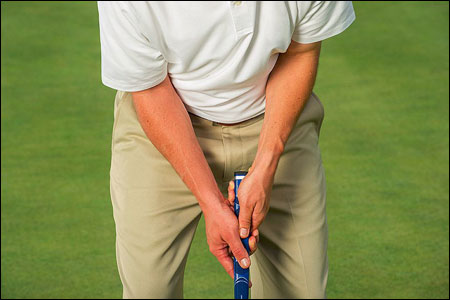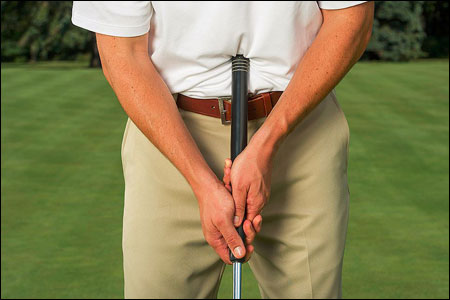R&A and USGA Announce Proposed Rules Change to Prohibit Use of Anchored Strokes
The Royal & Ancient (R&A) and the United States Golf Association (USGA), golf’s governing bodies, have announced proposed changes to the Rules of Golf that would prohibit anchoring the club in making a stroke.
The proposed Rule 14-1b, which follows an extensive review by The R&A and the USGA, would prohibit strokes made with the club or a hand gripping the club held directly against the player’s body, or with a forearm held against the body to establish an anchor point that indirectly anchors the club.


The proposed new Rule would not alter current equipment rules and would allow the continued use of all conforming golf clubs, including belly-length and long putters, provided such clubs are not anchored during a stroke. The proposed Rule narrowly targets only a few types of strokes, while preserving a golfer’s ability to play a wide variety of strokes in his or her individual style.
Prior to taking a final decision on the proposed Rule, The R&A and the USGA will consider any further comments and suggestions from throughout the golf community.
“We believe we have considered this issue from every angle, but given the wide ranging interest in this subject we would like to give stakeholders in the game the opportunity to put forward any new matters for consideration,” said Peter Dawson, Chief Executive of The R&A.
The proposed Rule change would take effect on January 1, 2016, in accordance with the regular four-year cycle for changes to the Rules of Golf. This timetable would also provide an extended period in which golfers may, if necessary, adapt their method of stroke to the requirements of the Rule.
For more information about the newly proposed Rule, as well as additional information including videos and images of strokes that would be allowed orprohibited by the proposed changes to Rule 14-1, visit www.RandA.org/anchoring or www.usga.org/anchoring.
New Rule Would Define and Preserve the Nature of the Stroke
In proposing the new Rule, The R&A and the USGA concluded that the long-term interests of the game would be served by confirming a stroke as the swinging of the entire club at the ball.
“Throughout the 600-year history of golf, the essence of playing the game has been to grip the club with the hands and swing it freely at the ball,” said USGA Executive Director Mike Davis. “The player’s challenge is to control the movement of the entire club in striking the ball, and anchoring the club alters the nature of that challenge. Our conclusion is that the Rules of Golf should be amended to preserve the traditional character of the golf swing by eliminating the growing practice of anchoring the club.”
New Rule Would Address Recent Developments in the Game
This proposal reflects The R&A’s and USGA’s responsibility to define how the game is to be played. Aspects of how a player must make a stroke have been addressed in past Rules changes, such as the century-old Rule codifying that the ball must be fairly struck and not be pushed, scraped or spooned and the 1968 prohibition on the “croquet” style of putting.
“As governing bodies, we monitor and evaluate playing practices and developments in golf, with our primary mandate being to ensure that the Rules of Golf continue to preserve the fundamental characteristics of the game,” added Davis.
Although anchoring the club is not new, until recently it was uncommon and typically seen as a method of last resort by a small number of players. In the last two years, however, more and more players have adopted the anchored stroke. Golf’s governing bodies have observed this upsurge at all levels of the game and noted that more coaches and players are advocating this method. The decision to act now is based on a strong desire to reverse this trend and to preserve the traditional golf stroke.
“Anchored strokes have become the preferred option for a growing number of players and this has caused us to review these strokes and their impact on the game,” said Dawson. “Our concern is that anchored strokes threaten to supplant traditional putting strokes which are integral to the longstanding character of the sport.”
The USGA is looking for your comments on this proposed Rules change!
Address your comments by mail to:
Rules of Golf (Rule 14-1)
United States Golf Association
P.O. Box 708,
77 Liberty Corner Rd.
Far Hills, NJ 07931-0708
Or send your comments via email to: [email protected] (and put “Rule 14-1 Change” in the Subject line)
Review Process and Timetable
Earlier this year, The R&A and the USGA announced that they were reviewing the subject of anchoring. There has been widespread discussion of the issue throughout the international golf community which has been noted by the governing bodies.
Each organization is expected to take a final decision on the proposed Rule change in spring 2013. Anyone wishing to provide written comments to theappropriate governing body is encouraged to do so by February 28, 2013 as directed on the respective websites:www.RandA.org/anchoring or www.usga.org/anchoring.
Note:
The proposed change would re-label current Rule 14-1 as Rule 14-1a, and establish Rule 14-1b as described below:
14-1b Anchoring the Club
In making a stroke, the player must not anchor the club, either “directly” or by use of an “anchor point.”
Note 1: The club is anchored “directly” when the player intentionally holds the club or a gripping hand in contact with any part of his body, except that the player may hold the club or a gripping hand against a hand or forearm.
Note 2: An “anchor point” exists when the player intentionally holds a forearm in contact with any part of his body to establish a gripping hand as a stable point around which the other hand may swing the club.
Download: ANCHORING THE CLUB-UNDERSTANDING RULE 14-1b (PDF, 2.2M)





